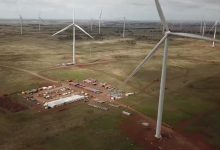Tilt Renewables says its 336MW Dundonnell wind farm in Victoria is on track to start sending its full output to the grid in time for summer peak demand, after a three-months delay triggered by unforeseen grid connection problems.
Tilt said the project was upgraded to a new 150MW hold point this week, and able to use all 80 of its turbines – from a previous 130MW hold point, with just 54 turbines operational – as it worked through a commissioning sequence “now required” by the Australian Energy Market Operator.
The wind farm, which achieved the feat of installing the largest wind turbines in the southern hemisphere safely and on time, has been making slow progress since July when AEMO raised “unanticipated concerns” around its connection to the grid.
At the time, Tilt CEO Deion Campbell described the delay as “unfortunate,” given the developers had followed the agreed commissioning plan as negotiated with AEMO in 2018, prior to financial close.
The company also warned of a hit the group’s earnings for the fiscal year, saying it would bring it in below the guidance range provided to the market in May 2020, somewhere in the range of $A65 million to $A80 million.
In comments this week, Tilt said that while the earnings downgrade remained in place, progress made together with AEMO had been “encouraging.”
“We believe the current mutual goal of reaching full output by the end of 2020 is achievable, assuming acceptable performance is observed throughout the remainder of the commissioning process,” Campbell said in a statement.
“This would represent a delay of approximately three months compared to the original project schedule.”
Months-long delays to the commissioning of completed projects, and constraints to the output of already operational projects, have been a common theme for large-scale wind and solar industry across the National Electricity Market due to grid congestion and also to voltage “oscillation” issues in certain areas.
In Victoria, AEMO has regularly warned of key network areas that are not currently strong enough to support the state’s planned renewable investment, with roughly 2,600MW of solar and wind under construction or – like Dundonnell – being commissioned.
Some wind and solar farms operating in the affected areas – one of which has been dubbed the “rhombus of regret” for the shape of the network and its limitations, and elsewhere in the broader West Murray region – have had their outputs curtailed, while others have been required to add new machinery known as synchronous condensers to ensure “system strength” is maintained.
Dundonnell, which sits well clear of the southern tip of the problem areas, had been progressing well and in April was declared to be “on track” to reach its full 336MW capacity well before the end of 2020, having started sending power to the grid in March.
That was not to be, however, and since July Tilt has been working with AEMO and the project’s turbine supplier, Vestas, on further performance modelling and testing to progress it through the commissioning sequence.
“This 150MW, 80 turbine status will allow the wind farm to produce roughly two thirds of the energy yield expected if the asset was fully operational without the cap, under P50 wind conditions,” the company said.
“Focus is now on progressing commissioning through the remaining hold points, towards full output near the end of 2020 and in time for the summer demand peak.”









